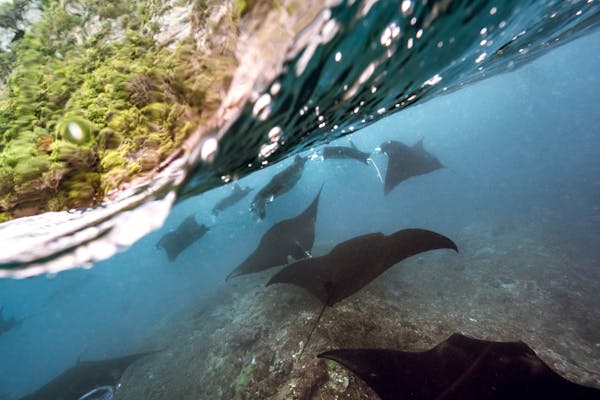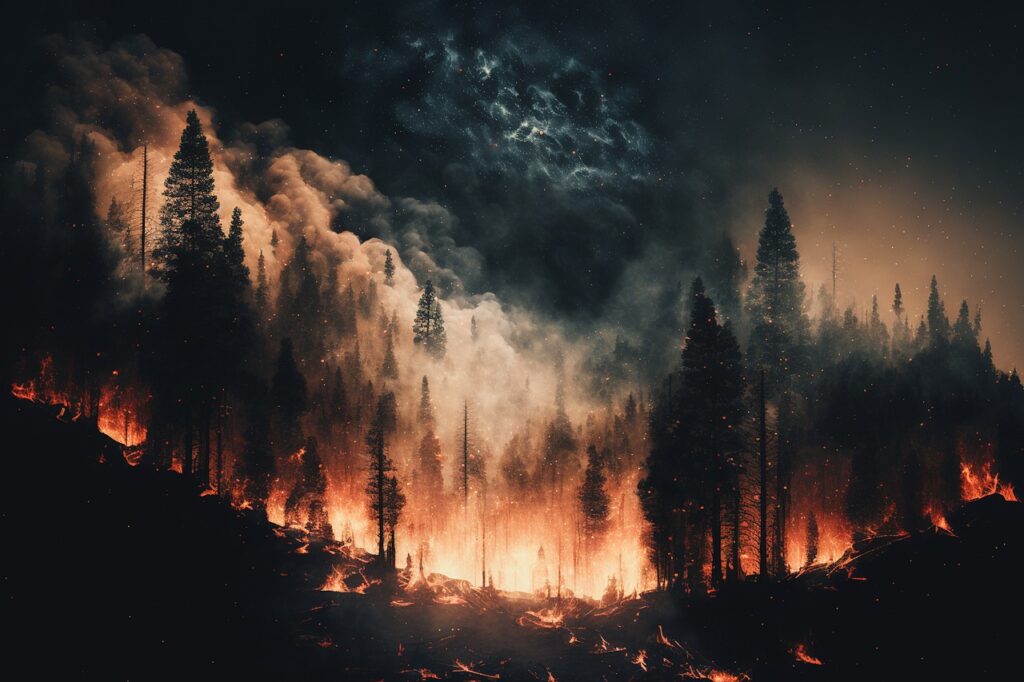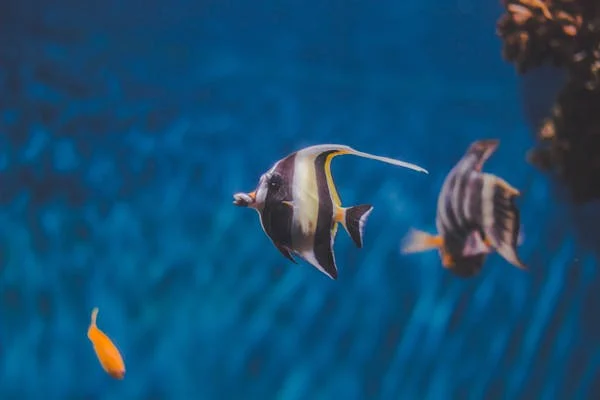what is climate change?
Climate Change presents a major existential threat, and how we respond to it will determine what our future looks like. But before we get to that, let’s get our facts straight.
Climate change is a long-term change in global and regional climate patterns. What it isn’t is “global warming” or unusual weather events. Global warming is a gradual increase in the overall temperature of the earth’s atmosphere, while weather is fluid and changes from day to day and year to year. Climate change is observed over a long period of time and includes the seasonal temperatures, rainfall averages, and wind patterns of a region. Its effects influence weather patterns, causing them to become less predictable.

Climate change continues to be an ever-present threat, affecting not just humans but also the diverse wildlife that shares our planet. As temperatures rise and extreme weather events become more frequent, the delicate balance of ecosystems is disrupted, endangering countless animal species. In this blog post, we explore “how does climate change affect animals” in 2023, from melting sea ice threatening polar bears to invasive species endangering native wildlife. By understanding these challenges, we can take action to protect our planet’s biodiversity and preserve the natural world for future generations.
Key Takeaways for How Does Climate Change Affect Animals
- Rising temperatures are having serious impacts on animal species, endangering their survival and necessitating conservation efforts.
- Invasive species driven by climate change pose a threat to biodiversity, while human activities such as deforestation and emissions of greenhouse gases Exacerbate the effects of climate change on wildlife.
- Conservation strategies through legislation, policy, and community initiatives are essential in protecting against these adverse impacts.

Impacts of Rising Temperatures on Animal Species
The changing climate has led to rising temperatures, causing a myriad of issues for animal species. Animals face challenges such as melting sea ice for polar bears, phenological mismatch for birds, and coral bleaching for ocean life. As habitats are altered and ecosystems disrupted, the survival of many species hangs in the balance.
We will now consider the specific impacts of rising temperatures on polar bears, birds, and marine life, underscoring the pressing need for conservation and adaptation strategies to safeguard these species in a dynamically changing world.
Polar Bears and Melting Sea Ice

The Arctic region has experienced a significant decline in sea ice extent, with ice surviving the summer melt season decreasing by approximately 13 percent per decade. This loss of sea ice has had a profound impact on polar bears, a species of concern under the Endangered Species Act. The melting sea ice disrupts their natural habitat and restricts their access to prey, such as seals. As a result, polar bears are compelled to swim longer distances and more frequently as the ice recedes, which can be strenuous and draining for them and other wildlife species.
With an estimated global population between 22,000 and 31,000 individuals, polar bears are facing a precarious future. The ongoing loss of sea ice in the Arctic region threatens their hunting grounds and survival, emphasizing the need for conservation efforts to protect this iconic species from the devastating effects of climate change.
Birds and Phenological Mismatch
Rising temperatures, also known as warming temperatures, are causing phenological mismatch, a phenomenon where interacting species alter the timing of their life cycle phases at different rates. This can result in decreased reproductive success for bird species, as they may arrive at their breeding grounds either too early or too late to take advantage of peak food availability.

For example, snowshoe hares undergo seasonal color molts as their habitats experience reduced snow cover, and mountain pygmy possums are forced out of hibernation earlier than their prey, the bogong moth. These disruptions in life cycles can lead to a lack of food availability and nesting for birds, further emphasizing the need to address the underlying issue of climate change and its impacts on these delicate ecosystems.
Coral Bleaching and Ocean Life
Coral bleaching is a phenomenon wherein sea corals expel the algae living in their tissues, resulting in a whitening of the coral. This occurs due to elevated ocean temperatures, which pose a serious threat to the survival of coral reefs and the marine life they support.

Species such as:
- butterfly fish
- spiny lobsters
- whales
- dolphins
- whale sharks
- hawksbill sea turtles
- various coral species like Acropora coral
are among the most vulnerable to coral bleaching. The frequency of coral bleaching events has a strong correlation with rising ocean temperatures, leading to increased coral mortality and posing a serious threat to marine biodiversity.
Addressing the root cause of climate change is vital to protect these fragile ecosystems and the countless species that depend on them.
Extreme Weather Events and Wildlife
In addition to rising temperatures, extreme weather events such as droughts and wildfires also have a detrimental effect on wildlife species. These events can disrupt aquatic species’ habitats and cause the destruction of terrestrial species’ homes. From the arid landscapes of the American West to the lush forests of the Southeastern United States, no region is immune to the impacts of extreme climate and climate change on wildlife.

The subsequent sections will detail the specific consequences of droughts on aquatic species and the havoc wreaked by wildfires on terrestrial species, highlighting the necessity for comprehensive conservation efforts to mitigate the effects of a transforming climate on our planet’s wildlife.
Droughts and Aquatic Species
Droughts, exacerbated by climate change, have major impacts on aquatic species’ habitats. These impacts include:

- Low water levels
- Warm water temperatures
- Poor forage conditions
- Increased risk of wildfires
All of these factors contribute to the decline of fish and invertebrate populations, altering food webs and diminishing ecosystem function.
Endangered species such as the Sacramento River winter-run and coldwater fish species are particularly vulnerable to reduced water quantity during drought periods. The decrease in water availability and subsequent habitat loss poses a significant threat to aquatic species, further emphasizing the need for adaptive management strategies and conservation efforts to safeguard these vital ecosystems.
Wildfires and Terrestrial Species
Wildfires, fueled by climate change, pose a significant threat to terrestrial species and their habitats. Some of the species that are at risk during wildfires include:

- Large animals such as deer and elk, especially those that are young, old, or already ill
- Bears
- Grey wolves
- Certain bird and lizard species
- Amphibians
The magnitude of the impact on these species depends on the intensity and scope of the fire.
The destruction of habitats caused by wildfires not only disrupts the lives of terrestrial species but also contributes to the loss of biodiversity. Efforts to prevent wildfires, restore damaged ecosystems, and protect vulnerable species are essential in the face of a climate crisis that shows no signs of abating.
Sea Level Rise and Coastal Habitats
Sea level rise is one of the consequences of climate change. Ocean water expands when it warms, and this combined with the melting of glaciers and ice sheets leads to seas rising. This rise in sea levels threatens coastal habitats, endangering wetland species and coastal forests.

The ensuing sections will scrutinize the effect of sea level rise on wetlands and their endangered species, in addition to the threats confronting coastal forests due to rising seas. Grasping these challenges is paramount for devising and implementing impactful conservation strategies to safeguard these susceptible ecosystems.
Wetlands and Endangered Species
Wetlands are home to many endangered species, but they face habitat loss due to rising sea levels. Increasing sea levels are causing coastal wetlands to be increasingly inundated and water levels to rise, leading to displacement and loss of wetland flora and fauna.

Species such as the Salt Marsh Harvest Mouse and Pacific Salt Marshes are particularly vulnerable to the effects of rising sea levels. As these vital ecosystems face inundation and degradation, the need for conservation efforts to protect wetlands and the species that depend on them becomes increasingly urgent.
Coastal Forests and Rising Seas
Coastal forests, which provide essential habitat for numerous species, are also at risk from rising seas. Sea level rise can lead to alterations in the groundwater table, resulting in saturated soils and increased salinity. This can cause saltwater intrusion, killing salt-sensitive trees and transforming coastal forests into ‘ghost forests’.
The loss of tree cover can disrupt the habitat and nesting sites of various species, while changes in the groundwater table and increased risk of flooding and erosion can further impact wildlife in coastal forests. Addressing the challenges posed by sea level rise is crucial to preserve these valuable ecosystems and the wildlife that depends on them for survival.
Invasive Species and Climate Change
Invasive species pose yet another threat to native wildlife and biodiversity, driven by climate change. As temperatures rise and ecosystems shift, certain areas that were previously inhospitable to invasive species may become suitable habitats, allowing them to establish populations and spread more rapidly.

Subsequent sections will delve into the repercussions of invasive plant and animal species on native wildlife and ecosystems, emphasizing the necessity for continuous monitoring and management efforts to preserve native species and uphold biodiversity in an evolving world.
Plant Invaders and Native Wildlife
Invasive plant species, encouraged by climate change, compete with native wildlife for resources and habitat. For example, tumbleweed, or Russian thistle, and other invasive species demonstrate resilience to warming and spread across landscapes.
These invasive plants can outcompete native species for resources and habitat, resulting in a decrease in biodiversity and a decline in the health of native wildlife populations.

Effective strategies for reducing the effects of invasive plant species include early detection and rapid response, control of invasive species, and restoration of native habitats.
Animal Invaders and Biodiversity
Invasive animal species, driven by climate-induced migration, also threaten biodiversity and native ecosystems. Climate change can create more favorable conditions for invasive animals to thrive and expand their range, as well as disrupt the natural balance of ecosystems, making them more vulnerable to invasions.

Examples of climate-induced invasive animal species include the Argentine ant in Hawaii and the Asian clam and water hyacinth in aquatic environments. The impacts of these invasive species on native ecosystems can be devastating, necessitating robust monitoring and management efforts to protect native wildlife and maintain biodiversity in the face of a changing climate.
Human Contributions to Climate Change and Wildlife
While the natural world is grappling with the effects of climate change, human activities have played a significant role in driving this global crisis. Through the emission of greenhouse gases and deforestation, humans are exacerbating the impacts of climate change on wildlife.
Future sections will examine the part played by greenhouse gases in global warming and the consequences of deforestation on habitat loss, underlining the call for united action to tackle the human contributions to climate change and safeguard our planet’s diverse wildlife.
Greenhouse Gases and Global Warming
Greenhouse gases, primarily released through the burning of fossil fuels, trap heat in the atmosphere, causing global warming and contributing to climate change’s impact on wildlife. By increasing greenhouse gas emissions, such as carbon dioxide, the natural greenhouse effect is intensified, resulting in a rise in global temperatures.
Numerous scientific studies have established a direct link between greenhouse gas emissions and wildlife impacts, such as:
- polar bear cub survival
- habitat loss for various species
- changes in migration patterns
- disruption of ecosystems
Addressing the root cause of greenhouse gas emissions is vital to protect wildlife from the detrimental effects of climate change, emphasizing the urgency of transitioning to sustainable energy sources and reducing our carbon footprint.
Deforestation and Habitat Loss
Deforestation, driven by human activities like industrial agriculture, timber logging, and mining, leads to habitat loss and exacerbates the effects of climate change on animals. With the current rate of deforestation at 160,000 square kilometers per year, approximately 1% of the original forest habitat is lost each year.
Numerous species, including:
- Orangutans
- Sumatran rhinos
- Chimpanzees
- Mountain gorillas
- Giant pandas
- Pygmy elephants
- Pygmy sloths
- Indian elephants
are most impacted by habitat loss due to deforestation. To protect these species and their habitats, it is crucial to implement sustainable land management practices and halt the destruction of the world’s forests.
Conservation Efforts and Adaptation Strategies
Conservation efforts and adaptation strategies can help protect wildlife from the impacts of climate change. Through legislation, policy, and community initiatives, we can address the various challenges faced by animals in a rapidly changing world.
Upcoming sections will discuss the function of legislation and policy in tackling climate change and conserving wildlife, alongside the significance of community-based initiatives in moderating the effects of climate change on animals.
Legislation and Policy
Legislation and policy play a significant role in addressing climate change and protecting wildlife by regulating emissions and promoting conservation. International policies, such as the Paris Agreement and the EU Biodiversity Strategy for 2030, aim to decrease greenhouse gas emissions, protect wildlife, and combat illegal wildlife trade.
By implementing effective legislation and policy, we can foster a global commitment to addressing climate change and its impacts on wildlife. These efforts are essential in preserving the natural world and ensuring the survival of countless species that depend on healthy ecosystems.
Community-Based Initiatives
Community-based initiatives, such as habitat restoration projects and renewable energy projects, can help mitigate climate change’s effects on animals by decreasing greenhouse gas emissions, avoiding habitat destruction, and fostering sustainable development.
Successful community-based initiatives that showcase the power of local action in addressing climate change and protecting wildlife include:
- NOAA’s Community-Based Restoration Projects
- The Great Green Wall
- Pakistan’s Tree Tsunami
- Belize Barrier Reef System
- NOAA’s Salt Marsh Restoration Project
By engaging communities in conservation efforts, we can work together to build a more sustainable future for both humans and wildlife.
Summary
In conclusion, the impacts of climate change on wildlife are vast and varied, from rising temperatures affecting polar bears and birds to the devastation of wildfires and the proliferation of invasive species. As we face a global climate crisis, it is crucial to take action to protect our planet’s diverse wildlife and preserve the natural world for future generations. Through legislation, policy, and community-based initiatives, we can address the challenges of climate change and work together to safeguard the habitats and species that enrich our world.
Frequently Asked Questions
How much animals are affected by climate change?
Climate change has already caused the extinction of many species, and is likely to cause more, as it currently affects at least 10,967 species on the IUCN Red List. Its impact on wildlife will be devastating and far-reaching.
Does climate change affect all animals?
Climate change impacts all animals, as rising temperatures affect vegetation, food sources, access to water and much more. This can cause habitats to become uninhabitable, forcing wildlife to migrate or die off, while allowing species that do better in warmer climates to outcompete others. A study published by Defenders of Wildlife found that all but one animal species are sensitive to the effects of climate change.
What are 3 animals affected by climate change?
Climate change has adversely affected a variety of animals, such as polar bears, snow leopards, giant pandas, tigers, monarch butterflies and green sea turtles.
How does climate change effect animals?
Rising temperatures are having a devastating effect on many species, causing habitat loss, lower survival rates due to less food and successful reproduction, and wreaking havoc on people’s livelihoods and communities. Climate change is causing direct harm to animals, destroying their habitats, and forcing wildlife to migrate in search of livable conditions.
What is phenological mismatch and how does it affect birds?
Phenological mismatch occurs when interacting species alter their life cycle phases at different rates, causing birds to arrive too late or too early for peak food availability, leading to a lack of nesting and food opportunities.


